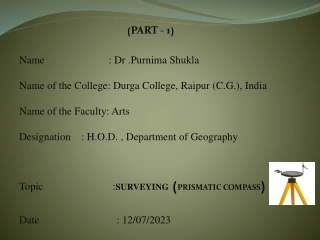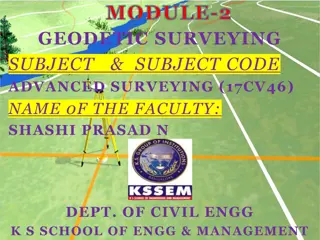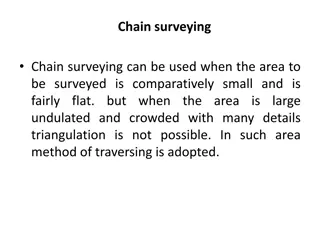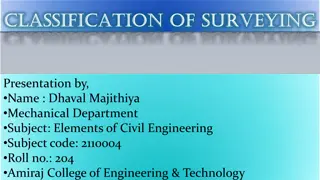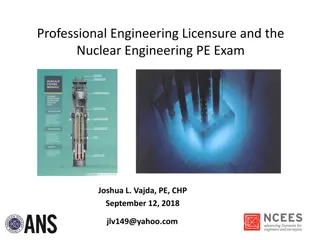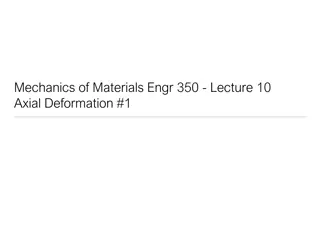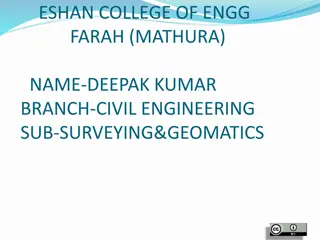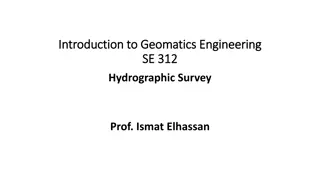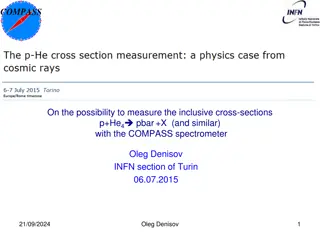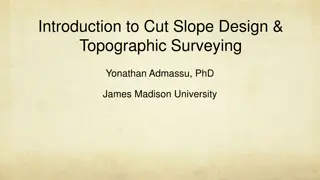Overview of Compass Surveying and Prismatic Compass in Engineering Technology Research
Explore the world of compass surveying and the prismatic compass in engineering technology research. Learn about the instruments used, principles of surveying, and the parts of a prismatic compass. Discover how these tools are essential for area calculation and accurate measurements in various engineering projects.
Download Presentation

Please find below an Image/Link to download the presentation.
The content on the website is provided AS IS for your information and personal use only. It may not be sold, licensed, or shared on other websites without obtaining consent from the author. Download presentation by click this link. If you encounter any issues during the download, it is possible that the publisher has removed the file from their server.
E N D
Presentation Transcript
Faculty of Engineering Technology & Research. Isroli, Afwa.
Name Enrollment no Roll no KUSHAL RATHOD 130840106053 68 KEVIN SHAH 130840106057 10 RAJ PATEL 130840106045 03 PARESH PATEL 130840106043 79 KRUNAL PATEL 130840106039 45 MOHAMMAD PATEL 130840106042 07 Guided by - Mr. Shivang Dabhi -Miss Ankita Upadhyay
COMPASS SURVEYING STUDY OF INSTRUMENTS AND AREA CALCULATION
Compass surveying The principle of surveying is traversing; which involves a series of lines which are connected
TYPES OF COMPASS PRISMATIC COMPASS SURVEYOR COMPASS
CONSISTING PARTS Cylindrical metal box Pivot Lifting pin and lifting liver Magnetic Needle Graduated Ring Prism Object vane Eye Vane Glass Cover 10. Sun Glasses 11. Reflecting Mirror 12. Spring Brake or Brake Pin 1. 7. 2. 8. 3. 9. 4. 5. 6.
INSTRUMENTS USED FOR COMPASS SURVEYING The various instruments used in the compass survey are : Prismatic compass Tape Ranging rods Tripod Arrows Plumb Bob
PRISMATIC COMPASS Prismatic Compass comprises of a magnetic needle attached to the circular ring made up of aluminum. The needle is on the pivot and will orient itself in the magnetic meridian The line of sight is defined by the objective vane and the eye slit, both attached to the compass box.
A triangular prism is fitted below the eye slit. The readings increase in clockwise direction. The object vane frame can be folded on the glass lid which covers the top at box.
lever which lifts the needle of the pivot and holds it against the glass lid. When bright objects are sighted dark glass may be interposed in to the line of sight.
Adjustments of Prismatic Compass: The following are the adjustments usually necessary in the prismatic compass: Centering Leveling Focusing the prism.
CENTERING: The center of the compass is placed vertically over the station point by dropping a small piece of stone below the center of the compass, it falls on the top of the peg marking that station. LEVELLING: By means of ball and socket arrangement the Compass is then leveled the graduated ring swings quite freely. It may be tested by rolling a round pencil on the compass box. FOCUSSING THE PRISM : The prism attachment is slid up or down focusing till the readings are seen to be sharp and clear.
WORKING OF SURVEYORS COMPASS Centering Levelling Observing the bearing line 1. 2. 3.
In this type of compass , reading is taken from the top of glass and under the tip of north end of the magnetic needle directly. No prism is provided here . Construction and bearing system of the surveyor s compass differs from prismatic compass .
TYPES OF MERIDIANS Magnetic Meridians and Magnetic Bearing 1. True Meridian and True Bearing 2. Arbitrary Meridian and Arbitrary Bearing 3.
TYPES OF BEARINGS True bearing Magnetic bearing Grid bearing 1. 2. 3. 4. Arbitrary bearing
REDUCED BEARING [RB] W.C.B OF ANY LINE QUADRANT IN WHICH IT LIES RULE FOR CONVERSION QUADRANT 1. 0 to 90 first RB = WCB N-E 2. 90 to 180 second RB = 180 - WCB S-E 3. 180 to 270 third RB = WCB - 180 S-W 4. 270 to 360 fourth RB = 360 - WCB N-W


